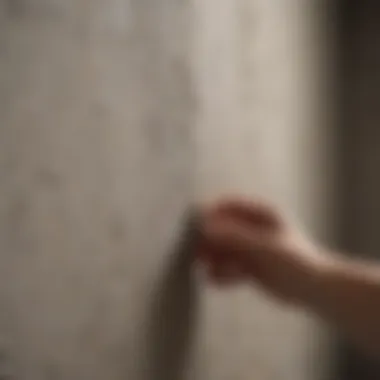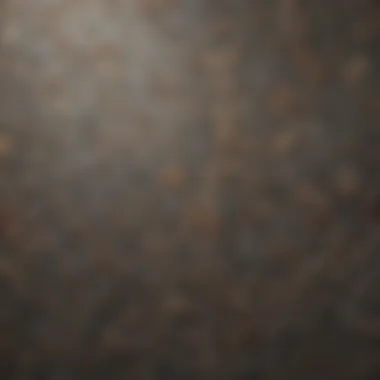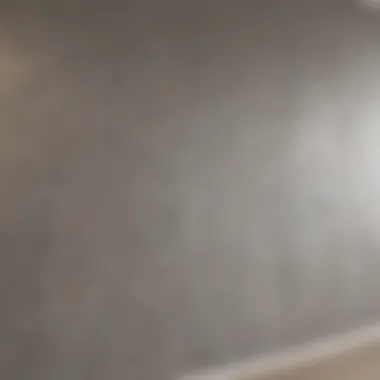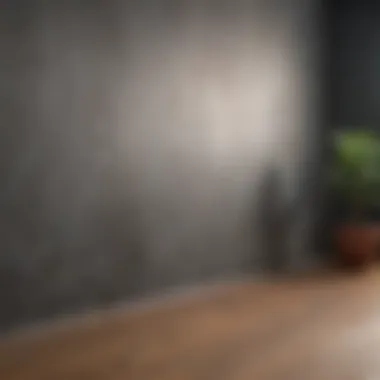Peel and Stick Wallpaper on Textured Walls


Intro
Peel and stick wallpaper has gained popularity among homeowners and design enthusiasts alike. Its ease of use and versatility make it an attractive option for updating spaces without the commitment associated with traditional wallpaper. However, applying peel and stick wallpaper over textured walls presents unique challenges. This guide will delve into the preparation needed, methods for application, the advantages and drawbacks of using this material, and the best practices for maintenance.
Understanding textured walls is critical. The texture can vary significantly, from subtle bumps to pronounced ridges. Each type of texture will impact how effectively the wallpaper adheres. This guide aims to provide thorough insights tailored specifically for those looking to enhance their walls with peel and stick solutions.
Preface to Peel and Stick Wallpaper
Peel and stick wallpaper presents a modern solution for various home decorating needs. Its importance lies in the convenience and versatility it offers to homeowners and design enthusiasts alike. The option to easily apply and remove wallpaper without traditional adhesive means a transformative interior can be achieved with minimal effort.
This guide aims to shed light on the numerous aspects of peel and stick wallpaper, particularly on textured walls. The kind of wall you have can significantly impact the effectiveness and overall look of the wallpaper. Understanding the characteristics of peel and stick wallpaper is crucial for successful installation and satisfaction with the final result.
Definition and Overview
Peel and stick wallpaper, as the name suggests, is a type of wallpaper that features a self-adhesive backing. This design allows for easy application; users simply peel off the protective backing and adhere the wallpaper to the desired surface. This type of wallpaper can be an excellent choice for individuals seeking a temporary solution or those who favor flexibility in their design choices. The range in designs and patterns means homeowners can find styles that suit their tastes, from abstract prints to nature-inspired themes.
Historical Context and Evolution
The concept of wallpaper itself has been around for centuries, evolving from intricate hand-painted murals to printed paper enhances. However, peel and stick wallpaper emerged in mid-20th century as a response to the need for more accessible home decor methods.
Initially, peel and stick versions were limited in design and texture, mostly appealing to budget-conscious consumers. Over the years, as manufacturing technology advanced, these products began to resemble traditional wallpaper more closely. Now, it is common to see peel and stick wallpaper in various styles, with materials that imitate textures and colors of non-removable options. This evolution reflects changing consumer preferences emphasizing ease, style, and temporary solutions in home decorating.
Current Trends in Wallpaper Design
Today, peel and stick wallpaper caters to a wide audience with different tastes and needs. Current trends highlight a move towards bold designs, such as geometric patterns and floral motifs. There is also an increased interest in eco-friendly materials. Many manufacturers offer peel and stick wallpaper made from sustainable resources, aligning with consumer interests in environmental impact.
Social media platforms, especially Instagram and Pinterest, play a significant role in shaping these trends. Users frequently share their creative installations, providing inspiration and encouraging others to explore wallpaper as a décor option.
"Peel and stick wallpaper is not just a product of convenience; it is a reflection of modern design trends that balance aesthetics with practicality."
Understanding Textured Walls
Textured walls present unique challenges and considerations when installing peel and stick wallpaper. It is crucial to grasp the various types of textures to ensure the wallpaper adheres properly. Different textures impact the wallpaper’s performance and longevity. Understanding the specific texture of your walls can lead to informed decisions regarding the wallpaper choice and installation technique.
Common Types of Wall Textures
Knockdown
Knockdown texture is characterized by its flattened, mottled appearance. This technique involves spraying a joint compound onto the wall and then knocking it down with a trowel. The result is a surface with subtle depth and dimension. This texture can be appealing because it adds visual interest while remaining somewhat subdued.
The irregular surface of knockdown can cause some complications during wallpaper application. Peel and stick products may not adhere well to the uneven areas. However, with careful preparation, it is possible to achieve satisfactory results.
Popcorn
Popcorn texture appears as a bumpy finish and is often found on ceilings and walls. This style is created by spraying a mixture onto the surface, resulting in a heavy, textured look. While it may have been popular decades ago, its aesthetic has fallen out of favor in modern interiors.
Popcorn texture can hinder proper adhesion when applying peel and stick wallpaper. The surface irregularity leads to pockets of air, reducing the adhesive's effectiveness. It’s advisable to either smooth the surface before wallpapering or select products specifically designed for such textures.
Stucco
Stucco has a robust, textured finish made from a mixture of cement, sand, and lime. Often associated with Mediterranean architecture, it provides a rustic charm. Stucco can be durable, ensuring its longevity.
It is also worth noting that while stucco surfaces are often attractive, they can pose a challenge for wallpaper installation. The roughness can prevent the wallpaper from fully adhering, leading to potential peeling or bubbling over time. Evaluating the overall condition of the stucco is important before proceeding with wallpapering.
Challenges of Installing Wallpaper on Textured Surfaces
Applying peel and stick wallpaper on textured walls can lead to several challenges. The primary issue is surface compatibility. Textures can create additional air pockets or uneven areas that hinder the adhesive behavior. Understanding these challenges helps in preparing the wall and successfully applying the wallpaper.
One must consider the following challenges:


- Adhesion Issues: Textures may make it harder for the wallpaper to stick properly.
- Air Bubbles: These can form in textured areas, ruining the appearance of the wallpaper.
- Repair Requirements: Some textures may need significant prep work to ensure a smooth application.
By recognizing the challenges, homeowners can take preventive measures and make informed choices regarding their wallpaper projects.
Assessing the Compatibility of Peel and Stick Wallpaper with Textured Walls
Assessing the compatibility of peel and stick wallpaper with textured walls is crucial for achieving a successful home decor transformation. Understanding this compatibility ensures more than just aesthetic appeal; it impacts the longevity and functionality of the wallpaper. Homeowners and design enthusiasts must consider several elements before proceeding with installation. Textured walls present unique challenges that require careful consideration.
The first factor to assess is the material composition of the wallpaper. Different types of peel and stick wallpapers utilize varying materials that can determine their adherence to textured surfaces. Some wallpapers, for instance, may be made of vinyl, while others use non-woven materials. The choice of material can impact how well the wallpaper conforms to the contours of the wall, influencing both the installation process and the final look.
Additionally, keeping in mind manufacturer guidelines is vital. Each brand may have its specific recommendations concerning the suitability of their product for textured surfaces. Ignoring these guidelines can lead to premature peeling or bubbling that undermines the wallpaper’s effectiveness and appearance.
Material Composition and Its Impact
Material composition directly influences the performance of peel and stick wallpaper on textured walls. Commonly, peel and stick wallpapers consist of various substrates. Understanding these substrates will inform homeowners about how they will perform on textured surfaces.
- Vinyl Wallpaper: This type of wallpaper is highly flexible and can often adapt well to uneven surfaces. It is also water-resistant, making it suitable for areas that may experience moisture.
- Non-Woven Wallpaper: This category is known for its breathability, allowing air to pass through. While non-woven wallpapers are easier to apply and remove, their performance on highly textured surfaces varies.
- Paper Wallpaper: Paper wallpapers tend to adhere poorly to significant textures. They can tear easily, especially during application and removal, making them less suitable for such surfaces.
The wallpaper's thickness and flexibility are also important. Thicker products may not adhere well, while those designed to be smooth can fill in the gaps created by texture, leading to a better overall appearance. Ultimately, choosing the appropriate material plays a critical role in the wallpaper’s interaction with the wall texture, which must be carefully considered during selection.
Manufacturer Guidelines and Recommendations
Researching and adhering to manufacturer guidelines is essential for a successful application of peel and stick wallpaper on textured walls. Each manufacturer provides specific instructions pertaining to the surface, including whether their wallpaper type is suited for textured surfaces.
It is advisable to consider:
- Surface Preparation: Most manufacturers will recommend specific cleaning methods for textured walls to ensure debris or dust doesn't disrupt adhesion.
- Temperature and Humidity Conditions: Variation in conditions can affect the adhesive properties. Understanding these conditions will help in proper application timing.
- Drying Time: After installation, there might be an advised period for not disturbing the wallpaper to let the adhesive set correctly.
Following these recommendations not only maximizes the adhesion of the wallpaper but also enhances its durability over time. If a homeowner can align their project with these guidelines, the chances of enjoying a beautifully wallpapered textured wall significantly increase.
Preparation Steps for Successful Application
The section on preparation steps is essential because it lays the foundation for a successful application of peel and stick wallpaper on textured walls. Proper preparation can determine how well the wallpaper adheres and how long it lasts. If insufficient attention is paid to these steps, the results may not meet expectations, leading to peeling or an uneven appearance.
Surface Inspection and Cleaning
Before applying peel and stick wallpaper, the state of the surface plays a crucial role in the outcome. Start by conducting a thorough inspection of your walls. Look for issues such as dirt, grease, or debris that could interfere with adhesion. It is wise to clean the surface using a gentle detergent mixed with warm water. For textured walls, ensure to reach into grooves and valleys where grime may accumulate. A soft sponge or cloth should suffice for most textures, while a more rugged cleaning brush may be required for stubborn spots. Dry the walls completely before proceeding, as moisture can also inhibit the adhesive’s performance.
Repairing Wall Imperfections
Repairing any imperfections is a crucial step in ensuring that your peel and stick wallpaper will not only adhere properly but also appear seamless. Wall imperfections like holes, dents, and cracks should be filled with an appropriate filler. After allowing these repairs to dry, sand the repaired areas until they are smooth and flush with the surrounding surface. This will ensure that your wallpaper sits evenly across the wall, providing a more professional finish. If major repairs are necessary, consider consulting with a professional.
Choosing the Right Wallpaper for Textured Walls
Selecting the appropriate wallpaper for textured walls is vital for achieving desired aesthetics and performance.
Patterns
Patterns can dramatically alter the overall feel of a space. They can draw attention or blend seamlessly into the decor. When choosing patterns, consider their scale in relation to the wall texture. Larger patterns may get lost on a very textured wall, while smaller patterns can enhance the depth of the texture. A key characteristic of patterns is their ability to create a visual flow that contributes to the room's ambiance. Popular choices include geometric shapes, floral designs, and abstract graphics because they can either complement or contrast with wall textures, resulting in a unique impression.
Color Schemes
Color schemes are another critical consideration when selecting wallpaper. They not only affect how light interacts with the space but also influence the mood. A well-chosen color can enliven a room or provide a soothing retreat. Light colors may help to expand small spaces by reflecting light, whereas dark tones can create intimacy. Mixing different hues can enhance visual interest. A key characteristic of color schemes is their ability to evoke emotions; therefore, selecting a scheme that resonates with the intended vibe of the space is important. Neutral tones can be versatile but may sometimes lack excitement, while bolder colors can energize a room.


Visual Impact
Visual impact refers to how wallpaper transforms a space's perception and function. Some designs can make rooms feel larger, while others can create a cozier atmosphere. The choice of wallpaper can serve as a focal point or subtle backdrop depending on the overall decorative strategy. One unique feature of visual impact is its ability to change according to different lighting conditions throughout the day. Thus, it's essential to consider how natural and artificial light will interact with the chosen wallpaper. Striking a balance between the wallpaper's visual presence and the existing decor will yield a harmonious living space.
Installation Process: Step-by-Step Guide
The installation process is crucial for achieving a successful application of peel and stick wallpaper on textured walls. Each step contributes to the overall quality and appearance of the finished product. A well-executed installation maximizes both aesthetic appeal and the lifespan of the wallpaper. It also minimizes common issues such as peeling or bubbling, which can detract from the overall look. Understanding the specific elements and considerations involved in this process can lead to a smoother experience and a more satisfying result.
Gathering Necessary Tools and Materials
Before beginning the installation, it is essential to gather all necessary tools and materials. Having the right items on hand will streamline the process and reduce frustrations.
- Wallpaper Rolls: Choose the design and pattern that fits your style.
- Utility Knife: A sharp utility knife is vital for precise cutting of the wallpaper.
- Measuring Tape: Accurate measurements are necessary to cut the wallpaper to the correct size.
- Level: A level ensures that your wallpaper is straight and aligns perfectly.
- Smoothing Tool: This tool helps eliminate bubbles and ensures adhesion to the wall.
- Cleaning Supplies: Keep a cloth or sponge handy to clean the walls prior to application.
Remember to verify that all tools are in good condition. A well-prepared workspace contributes significantly to the installation process.
Measuring and Cutting the Wallpaper
Proper measurement and cutting are paramount in achieving a seamless installation. Begin by measuring the height and width of the wall.
- Measure Twice: It’s often said that you should measure twice and cut once. This adage holds well in wallpaper installation. Take your time to ensure accuracy.
- Cut the Wallpaper: Once you have the measurements, lay the wallpaper flat and use the utility knife for cutting. Cut the wallpaper slightly longer than needed, allowing for adjustments after placement.
- Label the Sections: If using multiple strips, label each piece according to its placement sequence. This will help maintain organization during application.
Taking these steps will help ensure that the wallpaper fits perfectly on the wall.
Applying the Wallpaper to Textured Surfaces
Applying peel and stick wallpaper to textured surfaces requires attention to how the texture may affect adhesion and appearance. Start at one corner of the wall and gradually peel away the backing.
- Align the Wallpaper: Use the level to ensure the first strip is straight. Press it gently against the wall.
- Smooth it Down: As you apply the wallpaper, use the smoothing tool to push out any air bubbles. Start from the center and move outwards.
- Trim Excess: At the edges, trim any excess wallpaper for a tidy finish.
Each of these steps is crucial for achieving a smooth installation on textured walls.
Smoothing Techniques for Uniform Appearance
After applying the wallpaper, achieving a uniform appearance is critical for aesthetics. Follow these techniques to ensure the wallpaper adheres properly and looks flawless.
- Use the Right Amount of Pressure: Not too much and not too little. Just enough pressure helps in removing bubbles without damaging the wallpaper.
- Work in Sections: Focus on small sections of the wallpaper at a time, ensuring that each part is properly smoothed down before moving to the next.
- Check for Bubbles Frequently: As you move along, frequently check for bubbles and smooth them out as needed.
Using these techniques will help create a crisp and clean look for your newly papered wall.
Post-Installation Care and Maintenance
Post-installation care and maintenance of peel and stick wallpaper is crucial for ensuring that the installation remains visually appealing and functional over time. Many homeowners often overlook this aspect, which can lead to mishaps and reduce the longevity of the wallpaper. With the right maintenance strategies, it is possible to preserve the aesthetic and integrity of peel and stick wallpaper even on textured walls.
Cleaning Techniques for Peel and Stick Wallpaper
Regular cleaning is essential to keep peel and stick wallpapers looking fresh and vibrant. The surface should be cleaned gently to prevent damage. Here are some effective techniques:
- Dusting: Start with a soft, dry cloth or a feather duster to remove surface dust and debris. This minimizes the risk of scratches.
- Wiping: For deeper cleaning, use a damp cloth with mild soap. Avoid harsh chemicals as they may cause peeling or discoloration.
- Spot Cleaning: If specific stains appear, spot treat them with a mixture of water and a small amount of dish soap. Gently dab the area and avoid soaking the wallpaper.
Addressing Peeling or Bubbling Issues
Peeling or bubbling can occur, especially on textured surfaces. Recognizing and addressing these issues promptly can help mitigate further damage. Here are steps to take:


- Inspect the Area: Often conduct a visual check for signs of peeling or bubbles. Check corners and edges closely.
- Reapply Adhesive: If you notice peeling, carefully lift the corner of the wallpaper and reapply the adhesive. Press down firmly afterwards for a secure bond.
- Smooth Out Bubbles: For bubbles, gently poke the bubble with a pin to release air, then smooth out with a flat tool or your fingers. Take care not to tear the wallpaper.
- Climate Consideration: Be mindful of how changes in temperature and humidity can affect the wallpaper. These factors can contribute to peeling or bubbling. Ensure the room maintains a stable environmental condition.
It is advisable to regularly review the wallpaper's condition and make necessary adjustments. By emphasizing post-installation care, homeowners can enjoy the aesthetic benefits of peel and stick wallpaper while minimizing long-term issues.
Longevity and Durability of Peel and Stick Wallpaper
Understanding the longevity and durability of peel and stick wallpaper is crucial for homeowners and design enthusiasts interested in this application method. This aspect influences not only the aesthetics of a room but also the practical efficiency of the chosen product. It is vital to evaluate how long the wallpaper will last when applied over textured surfaces and what external factors can help or hinder this longevity.
Expected Lifespan on Textured Walls
The expected lifespan of peel and stick wallpaper on textured walls can vary significantly. Generally, these wallpapers can last anywhere from five to fifteen years, depending on materials used and conditions of the environment. Manufacturers provide guidelines for expected durability, but textured surfaces pose unique challenges. The unevenness of textures like popcorn or stucco can affect adhesion and cause peeling over time. Proper installation and preparation are essential to maximize the lifespan of the wallpaper.
Key Considerations for Lifespan:
- Quality of Product: Higher-quality peel and stick wallpapers typically offer better durability.
- Installation Method: Proper installation techniques can significantly enhance the wallpaper's lifespan, especially on textured walls.
Factors Influencing Longevity
Several factors can impact the durability and longevity of peel and stick wallpaper when installed on textured walls. Understanding these factors helps in making informed decisions and ensuring a successful application.
Humidity
Humidity is a critical element influencing the lifespan of peel and stick wallpaper. High humidity levels can weaken the adhesive and cause the wallpaper to lift. In humid environments, moisture penetrates the wallpaper, potentially damaging the integrity of the adhesive.
Key Characteristics of Humidity:
- High humidity can lead to mold growth if the wallpaper is not properly applied or maintained.
- Humidity-resistant wallpapers are valuable for areas prone to moisture, such as kitchens and bathrooms.
Temperature
Temperature plays a significant role in the longevity of the wallpaper. Extreme temperature fluctuations can cause the wallpaper material to expand and contract. This can lead to slippage or bubbling if the adhesive does not adjust well. It’s essential to apply the wallpaper in a controlled environment to maintain adhesive effectiveness.
Key Characteristics of Temperature:
- Ideal installation conditions require moderate temperatures to ensure fabric stability.
- Extreme cold can make the adhesive less effective, while heat can soften it, potentially leading to a loss of grip.
Light Exposure
Light exposure is another factor worth considering. Direct sunlight can fade and weaken peel and stick materials over time. Rooms that receive a lot of natural light may require special UV-resistant wallpapers to maintain their vibrant appearance and structural integrity.
Key Characteristics of Light Exposure:
- UV resistance in wallpaper can prevent fading and prolong the decorative features of the product.
- Areas with limited light may not present the same risks, but long-term exposure, regardless, can be detrimental.
It is essential to assess all the factors discussed above to ensure the best performance of peel and stick wallpaper on textured walls. The right preparations and conditions will lead to an aesthetically pleasing and durable solution that enhances your living space.
The End: Assessing Suitability for Your Space
The final stage in the consideration of peel and stick wallpaper over textured walls is assessing its suitability for your individual space. This evaluation is vital, as it encompasses several key factors that influence not just aesthetic appeal but also practical functionality. Understanding your personal style, the characteristics of your wall surface, and the overall context of your living space will guide you in making an informed decision.
Evaluating Personal Style and Practical Needs
When selecting wallpaper, aligning it with your personal style is essential. Consider the mood you aim to create in your rooms. Some individuals prefer calming neutral tones, while others might opt for bold, striking patterns. Each choice can significantly impact the ambiance of the space.
Additionally, practical needs must be factored into your decision. Are you looking for something durable that can withstand high traffic? Or are you focused on temporary solutions that allow flexibility in design? Knowing when and how you use the space will guide your wallpaper choice. For example, a child’s playroom may benefit from a more playful design that can easily be replaced as preferences change.
Reflecting on Cost vs. Value
Cost consideration is another critical aspect. Peel and stick wallpapers tend to be more affordable than traditional wallpaper or paint. However, it's essential to assess the value you gain from your investment. Evaluating long-term benefits is necessary. If the wallpaper adds charm and longevity to your decor, then the initial cost may be justified.
Moreover, consider maintenance expenses. Is the wallpaper easily cleanable? How well does it hold up against everyday wear? For instance, high-quality brands usually come with warranties and better adhesive strength, translating to a better value over time.







